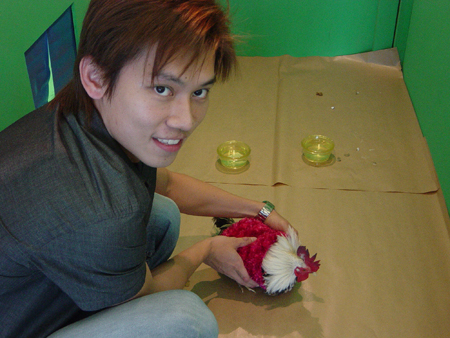Poultry are one of the most badly treated animals in the modern world. It has been shown that they have high levels of both cognition and feelings and as a result there has been a recent trend of promoting poultry welfare. There is also a tradition of keeping poultry as pets in some parts of the world. However in modern cities and societies it is often difficult to maintain contact with pets, particularly for office workers. We propose and describe a novel cybernetics system to use mobile and Internet technology to improve human-to-pet interaction. It can also be used for people who are allergic to touching animals and thus cannot stroke them directly. This interaction encompasses both visualization and tactile sensation of real objects.
The system overview is shown in Figure 1. It consists of a Office System and a Backyard System. Figure 2 shows in the Office System, where the pet owner touches the doll, and at the same time feels the movement of the doll as driven by a positioning mechanism table. Figure 3 shows the pet (we use a rooster) with a “pet dress” worn on its body. The pet dress consists of electronics that simulates touch (or haptic) sensation. It feels it when the pet owner fondles with the doll in the Office System.
Figure 1.The Poultry Internet with human interacting with pet through the internet. Figure 2. The Office System where user fondles with the doll. Figure 3. The pet (Charlie) with pet dress.
The idea was inspired by acts of pets and animal abuse through lack of welfare. This system enables humans to provide care for pets even though they are physically not together. The system enables a human to remotely touch her pet which is kept at home while she is away(in her office), and at the same time monitor the movement of the pet. This is realized by using a doll, which resembles the real pet located remotely, sitting on a mechanical positioning table. The pet owner interacts with the real pet by touching the doll.
Figure 4. Human remotely touching poultry pet through doll interface
Figure 5. Pet movement tracked in Backyard system and replicated on the Human end
Figure 6. Prof Adrian Cheok with pet chicken, Charlie
Video: http://video.google.com/videoplay?docid=4867370887133831803&hl=en
Media & press coverage: http://www.twango.com/media/mxrlab.pinternet/mxrlab.10665?sort=5
Journal Research paper: http://www.twango.com/media/mxrlab.pinternet/mxrlab.10329?sort=5
List of Research Publication: http://www.twango.com/media/mxrlab.pinternet/mxrlab.10667?sort=5
Flowchart: http://www.twango.com/media/mxrlab.pinternet/mxrlab.10666?sort=5
Exhibition History
Montreal, CHI 2006, the premier HCI conference in the world.
Version 05, Chicago USA, 2005
ICEC, Einhoven, 2004
Singapore Science Center, December 2006
Images
http://www.twango.com/channel/mxrlab.pinternet
Video Documentation
Poultry Internet�
Exhibition History
Montreal, CHI 2006, the premier HCI conference in the world.
Version 05, Chicago USA, 2005
ICEC, Einhoven, 2004
Press/Media Links
Straits Times Newspaper Interview with James Teh, MXR Researcher
Awards Honorary Mention at VIDA 8.0 Art & Artificial Life International Competition, Fundación Telefónica. Team Teh Keng Soon James, Lee Shang Ping, Dr. Adrian David Cheok
Poultry are one of the most badly treated animals in the modern world. It has been shown that they have high levels of both cognition and feelings and as a result there has been a recent trend of promoting poultry welfare. There is also a tradition of keeping poultry as pets in some parts of the world. However in modern cities and societies it is often difficult to maintain contact with pets, particularly for office workers. We propose and describe a novel cybernetics system to use mobile and Internet technology to improve human-to-pet interaction. It can also be used for people who are allergic to touching animals and thus cannot stroke them directly. This interaction encompasses both visualization and tactile sensation of real objects.
The system overview is shown in Figure 1. It consists of a Office System and a Backyard System. Figure 2 shows in the Office System, where the pet owner touches the doll, and at the same time feels the movement of the doll as driven by a positioning mechanism table. Figure 3 shows the pet (we use a rooster) with a “pet dress” worn on its body. The pet dress consists of electronics that simulates touch (or haptic) sensation. It feels it when the pet owner fondles with the doll in the Office System.

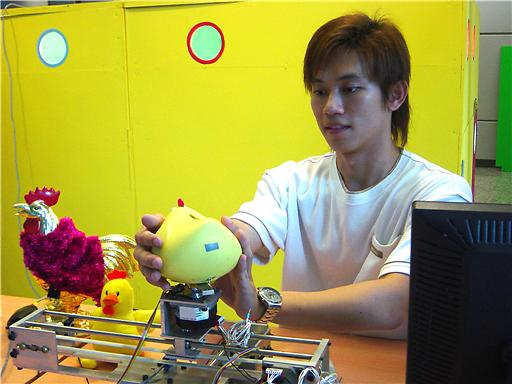
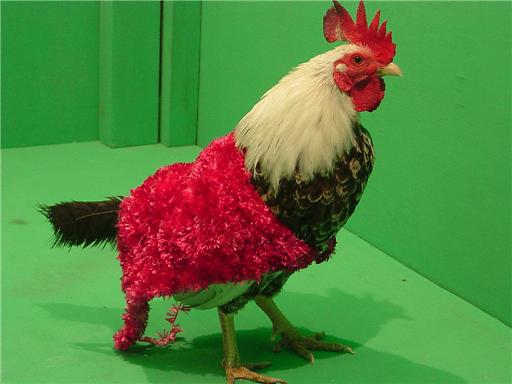
The idea was inspired by acts of pets and animal abuse through lack of welfare. This system enables humans to provide care for pets even though they are physically not together. The system enables a human to remotely touch her pet which is kept at home while she is away(in her office), and at the same time monitor the movement of the pet. This is realized by using a doll, which resembles the real pet located remotely, sitting on a mechanical positioning table. The pet owner interacts with the real pet by touching the doll.
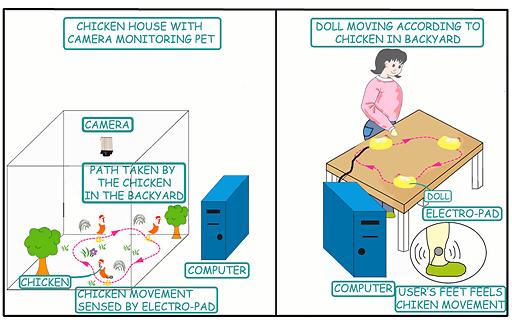
Figure 4. Human remotely touching poultry pet through doll interface
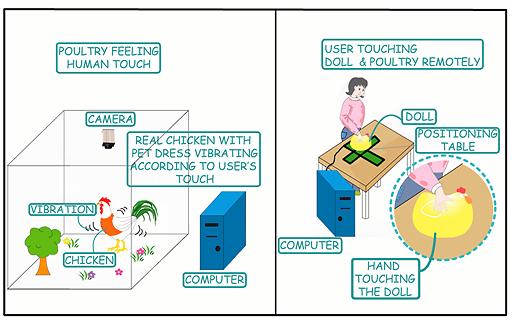
Figure 5. Pet movement tracked in Backyard system and replicated on the Human end
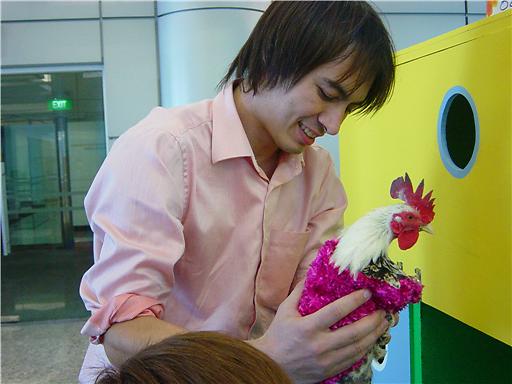
Figure 6. Prof Adrian Cheok with pet chicken, Charlie
Images: http://www.twango.com/channel/mxrlab.pinternet
Video: http://video.google.com/videoplay?docid=4867370887133831803&hl=en
Media & press coverage: http://www.twango.com/media/mxrlab.pinternet/mxrlab.10665?sort=5
Journal Research paper: http://www.twango.com/media/mxrlab.pinternet/mxrlab.10329?sort=5
List of Research Publication: http://www.twango.com/media/mxrlab.pinternet/mxrlab.10667?sort=5
Flowchart: http://www.twango.com/media/mxrlab.pinternet/mxrlab.10666?sort=5
Exhibition History
Montreal, CHI 2006, the premier HCI conference in the world.
Version 05, Chicago USA, 2005
ICEC, Einhoven, 2004
Singapore Science Center, December 2006
Images
http://www.twango.com/channel/mxrlab.pinternet
Video Documentation
Exhibition History
Montreal, CHI 2006, the premier HCI conference in the world.
Version 05, Chicago USA, 2005
ICEC, Einhoven, 2004
Press/Media Links
Straits Times Newspaper Interview with James Teh, MXR Researcher
